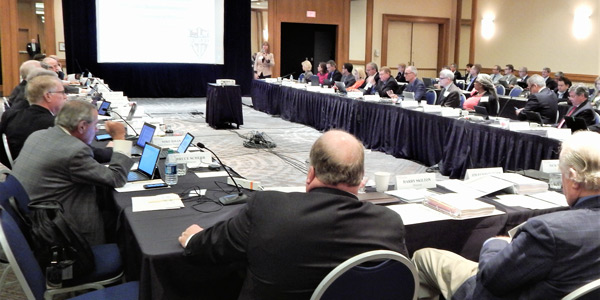By Tom Kleckner
TULSA, Okla. — The issue of cost shifts within transmission pricing zones may soon surpass transmission upgrade credits as one of the most vexing problems facing SPP stakeholders.
Strategic Planning Committee Chair Mike Wise said last week that his committee has been unable to reach consensus on a more equitable means of determining cost shifts when new members join existing transmission pricing zones despite talks that began in January.
Kansas City Power and Light called for revising SPP’s policy after the RTO put the City of Independence, Mo., into the utility’s transmission pricing zone, increasing costs for KCP&L customers. (See Strategic Planning Committee to Continue Work on Tx Cost Shifts.)
The SPC held two special meetings during April — a month in which it doesn’t normally meet — trying to reach consensus on a staff proposal for a “symmetrical” cost/benefit analysis and a phase-in process for regulatory assets that evaluates the time value of money.
“During discussion, it became clear we still didn’t have agreement on staff’s proposal,” Wise told the Board of Directors and Members Committee last Tuesday. “It’s concerning to me that in the stakeholder process, we couldn’t come to a conclusion on this.”
The SPC last met April 20 in Dallas, where it voted on a motion to adopt part of staff’s proposal, rejecting calls to end the discussion entirely. The motion included a reference to “the understanding that the SPC does not endorse the outcome of any staff zonal placement decisions.”
“Basically, [we] just approved a staff process for communication of potential zonal placements,” KCP&L’s Denise Buffington said.
She said in January her company would likely file a complaint with FERC if the SPC doesn’t resolve the issue “to our satisfaction and in a timely manner.” Stakeholders did agree to the first steps in the process, which begin with the applicant transmission owner (ATO) notifying SPP of its intention to join the RTO. Staff would then request data from the ATO, study the zonal placement and cost analysis, and facilitate discussions between the ATO and the transmission zone’s incumbents.
Staff’s straw proposal suggested that the ATO be given an opportunity to negotiate cost shifts with the other transmission owners and network customers in the affected zone, with any resulting agreements filed with FERC.
If no agreement is reached, SPP proposed filing a cost-shift mitigation plan if the shift increased network customers’ baseline costs under Schedule 9 of the Tariff by more than 2.5%.
But staff now say there is little consensus for having a cost-shift threshold. Several stakeholders were adamant that they did not want SPP deciding what costs would be placed upon their customers.
“The problem is not with the mitigation, but the zonal placement criteria,” Buffington said. “The criteria lead to the zonal placement, and it’s the zonal placement that leads to cost shifts. The criteria that [dictate] the placement [are] the problem.”
Staff has suggested using the following criteria in determining whether to place the facilities in a new zone:
- Whether the transmission facilities’ annual transmission revenue requirement (ATRR) is less than the minimum zonal ATRR benchmark;
- The extent to which the transferring facilities substantively increase the SPP regional footprint; and
- The extent to which the transferring facilities’ load received network service or long-term firm point-to-point service within existing zones prior to the transfer.
If the facilities are not placed in a new zone, staff would apply the following criteria in determining the existing zone in which to place the facilities:
- The extent to which the facilities are embedded within an existing zone;
- The extent to which the facilities are integrated with an existing zone; and
- The extent to which the facilities load received network service or long-term firm P2P service within each existing zone prior to the transfer.
Buffington has been leading the work on a revision request (RR172) that she said would establish a bright line between the costs of legacy transmission and new facilities planned by SPP to protect customers from paying for facilities that were not jointly planned. That work has been on hold, pending the SPC discussions.
Wise agreed the SPC would return with another update for the July meeting in Denver.
“This cannot die where it is,” Board Chair Jim Eckelberger said.






